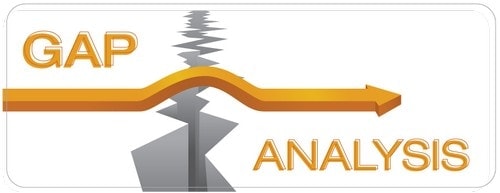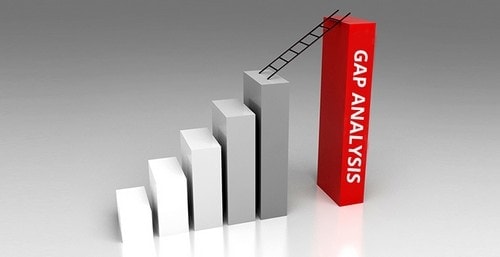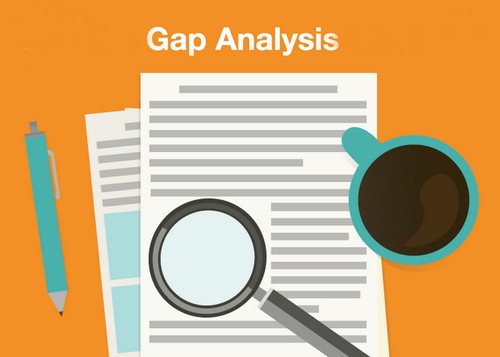Gap analysis is the difference between the actual performance of an organization and the desired or potential performance. If the current resources of an organization are underused and relinquish investment in technology or capital, then the organization will underperform.
Gap analysis recognizes gaps between the augmented allocation, the current allocation level, integration of resources and finally the areas of improvement. By this analysis, areas which require improvement can be identified.
Gap analysis encompasses Finding out, detailing, and improving the variance between requirements of business and current capabilities of the organization (such as resources, technology, capital, etc.).
Gap analysis can be easily determined using benchmarking and from other valuations. Once the expected performance of the company is determined, then it can be easily compared with the current level of performance of an organization.
This comparison is called gap analysis. This type of analysis can be performed at the operational or strategic level of the organization.
It can also be termed as a business analysis of an organization for what it is currently doing and where it wants to be in the future. Gap analysis can be performed from various perspectives such as human resources, business processes, business direction, and information technology. Gap analysis helps in measuring investment of money, time, and human resources to attain a particular result.
For example, changing the salary payment system of the organization from paper-based to paperless system. Gap analysis can also be used to determine how well a product or solution is fulfilling the required needs.
In this scenario, the outcome Gap analysis can be ranked as Good, Average, or Poor. By performing Gap analysis, one can determine what new products must be added or what another kind of addition must be done in the existing system. The Gap must be filled by the organization to survive the competition and grow in the market.
Table of Contents
Types of Gap
There are four types of Gaps.
1) Product/Market gap
Product or market gap can be defined as the difference between the actual sales performed and budgeted sales.
2) Performance Gap
The performance gap can be defined as the gap between the actual performance and expected performance.
3) Manpower Gap
The manpower gap can be defined as the difference between the actual strength of the organization and quantity and the required number of workforces.
Video on Gap Analysis
Advantages of Gap analysis
- It ensures that the project requirements have been met as desired.
- It gives insight into the areas which require improvements such as products, efficiency, processes, profitability, performance, customers’ satisfaction, competitive advantage, and participation.
- It helps in determining the areas which are weak and have shortcomings and to address those weaknesses and shortcomings.
- It helps in uncovering the difference between perception and reality.
- It helps in determining the best places to deploy focus energy and resources.
- It provides information to make a better decision, which further helps in improving performance.
- If Gap analysis is performed the outcomes of gap analysis rightly can be understood clearly and easily.
Disadvantages of Gap Analysis
- However, Gap analysis unleash the causes of some problems. But if it does not go deep enough, then the real cause of the problem can be left unsolved, and various complexities behind them can be missed.
- The success of Gap analysis highly depends on the persistence and knowledge of people involved in the gap analysis process.
- There are high chances that the outcomes of analysis can be wrong as the grounds frequently changes, especially in large organizations.
How to Perform a Gap analysis?
In big organizations, the job of conducting gap analysis is of project managers, business analysts, management, or process improvement teams. However, if a little bit of training and well-designed template of steps is provided, then anyone can perform the gap analysis efficiently.
Some organization keeps the guidelines that can be followed to perform a gap analysis. In this section, you will learn about the basic steps which should be followed to perform a successful gap analysis.
1) Determine the area to be analyzed and goals to be accomplished
For example, if your goal is to determine why is your factory not meeting the output target. Then you should find out the causes which are contributing to targets to not to be met and suggest solutions to remove those causes.
2) Establish the ideal future state
Set a future stage where you want to reach if everything works out as per plan.
3) Analyze the current state
What are the causes of targets to not be met? For example, do workers lack training? Was the production department understaffed? Were the required materials available constantly? Was the layout of production floor hindrance in reaching the goal?
4) Compare the actual state with an ideal state
What is the difference between the actual production and desired production? For example, are you required to produce 100 units per hour, but managed to produce only 80 units?
5) Describe the gap and quantify the difference
In the above example of unit production, the production was shortfall by 20%. After performing research to determine the causes outline the contribution of each to the shortfall.
6) Make a report of recommendations and create a plan to bridge the gap
After making the analysis, you should decide what changes are required to be made and what steps should be taken to bridge the gap. In our example, the analysis team might decide that layout issue is an easy way to deal with the problem and will make maximum impacts, and they might also suggest ways to address it.
They can also work with staffing and supply chain teams to implement recommendations to tackle issues. Ideas will be summarized and presented to management for further approval for action.
Examples of Gap Analysis
There are many areas of business such as sales, accounting, customers’ services, etc. which can make the use of Gap analysis. Here are a few examples of that can help you to understand the broad applicability of Gap analysis.
1) Productivity
When your company’s productivity level does meet the expectations that you have for your company or various business requirements laid out can be fixed using a Gap analysis.
2) New Product Launch
When your company launches a new product, a Gap analysis can be conducted to determine why sales are not meeting estimations.
3) Sales Performance
A manufacturer can look at his catalogue or products to determine which products are performing well and which aren’t. In this way, he can determine if he is producing the right product mix or he needs to make some changes to make more profits and meet the demands in the future.
4) Supply Management
If a store finds itself running out of supplies frequently, then they can run a Gap analysis to find out the reason behind it.
5) Product evaluation
Gap analysis can be performed by a software company to determine all functions and features drawn in requirements of a business are present and working as per the expectations.
6) Individual Assessment
Gap analysis can be given to the team of members by team leader as an activity. The outcomes of this activity will not only determine the ways to improve performance of each person but also find out the best practices that one should adopt to improve their performances so that their productivity can be enhanced.
Liked this post? Check out the complete series on Strategy



